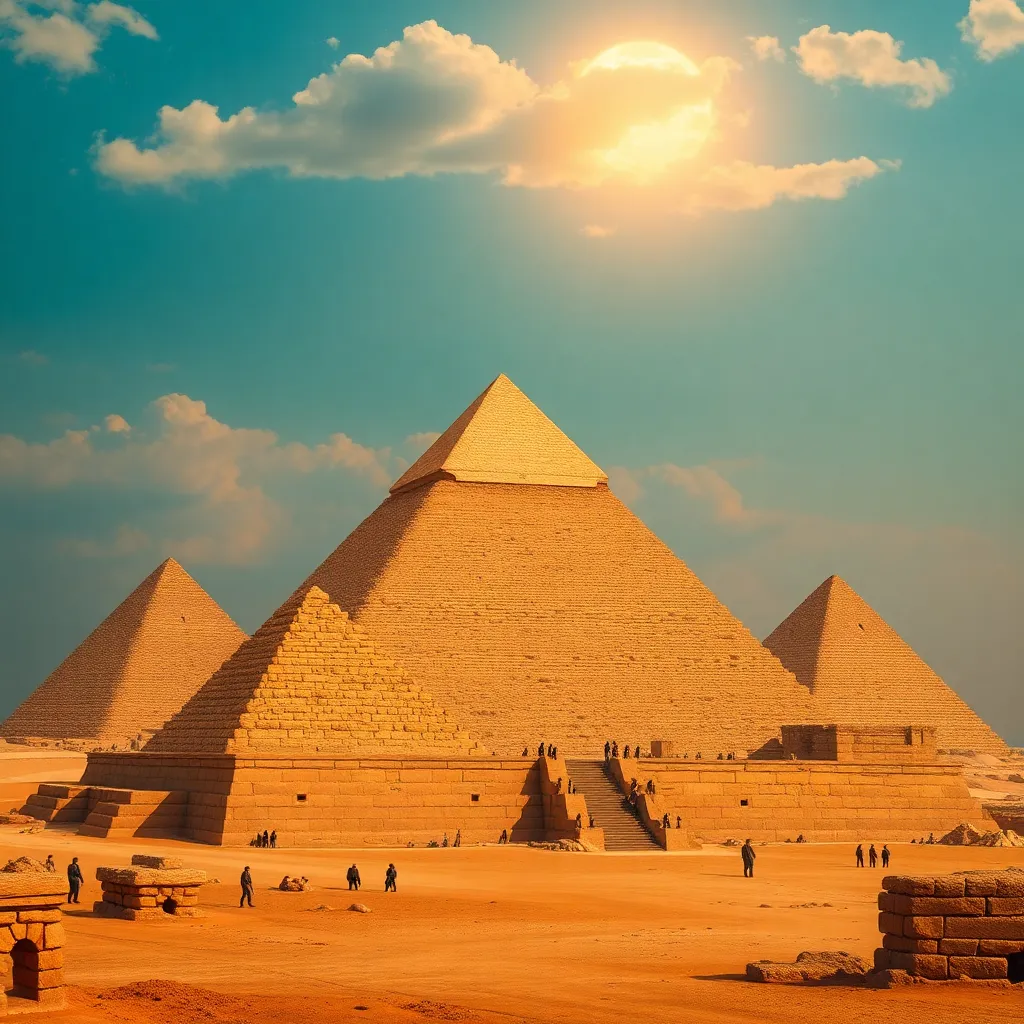The Pyramids: A Journey Through Egyptian History
1. Introduction to the Pyramids
The pyramids of Egypt stand as one of the most iconic symbols of ancient civilization. These monumental structures, primarily built as tombs for pharaohs, are not just remarkable architectural feats but also significant cultural symbols. Their grandeur reflects the beliefs, societal structure, and technological advancements of ancient Egyptian society.
Historically, the pyramids served as a means to facilitate the transition of the deceased pharaohs into the afterlife, a critical aspect of Egyptian spirituality. They were intended to honor and protect the pharaoh’s body and possessions, ensuring a successful journey to the next world.
2. The Evolution of Pyramid Construction
The evolution of pyramid construction is a fascinating journey through time, showcasing the ingenuity of ancient Egyptian architects and laborers.
- Early Tomb Structures: Mastabas – Before the pyramids, the Egyptians built mastabas, which were flat-roofed and rectangular structures. These served as the earliest form of tombs, primarily for the elite. Mastabas were constructed from mudbrick or stone and were designed to protect the burial chamber beneath.
- Transition to Step Pyramids – The next significant development was the step pyramid, exemplified by the Step Pyramid of Djoser at Saqqara. This pyramid marked a pivotal shift in burial architecture, featuring a series of mastaba-like layers stacked on top of each other, creating a stepped appearance.
- Development of True Pyramids – The true pyramid shape emerged during the Fourth Dynasty, with the most famous examples located on the Giza plateau. These pyramids, including the Great Pyramid, represent the culmination of architectural evolution and reflect the Egyptians’ advanced understanding of geometry and construction techniques.
3. The Great Pyramid of Giza: Engineering Marvel
The Great Pyramid of Giza, built for Pharaoh Khufu, is the largest and most renowned of all the pyramids. Its construction has long been a subject of fascination and is considered one of the Seven Wonders of the Ancient World.
The dimensions of the Great Pyramid are staggering: it originally stood at 146.6 meters (481 feet) and covers an area of approximately 13 acres. The precision in its construction is evident, with each side of the base aligned almost perfectly with the cardinal points.
Constructing such a monumental edifice required a massive workforce, estimated to be in the thousands, including skilled laborers, architects, and seasonal workers. The logistics of transporting and assembling the stones, some weighing over two tons, involved sophisticated planning and resources.
Symbolically, the Great Pyramid served multiple purposes in ancient Egyptian beliefs, representing the pharaoh’s divine power and his connection to the gods. Its alignment with the stars and the sun reflects the Egyptians’ intricate understanding of astronomy and their desire for immortality.
4. The Role of Pyramids in Egyptian Religion
Pyramids were deeply intertwined with Egyptian religious beliefs, particularly regarding the afterlife. The ancient Egyptians believed in an eternal life beyond death, and the pyramid was seen as a gateway to this afterlife.
- Connection to the Afterlife – The pyramid served as a physical representation of the pharaoh’s journey to the afterlife, where he would continue to rule over the land of the living.
- The Concept of Resurrection – The burial practices surrounding the pyramids, including elaborate rituals and the inclusion of grave goods, were intended to ensure the pharaoh’s resurrection and continued existence in the afterlife.
- Religious Texts and Inscriptions – Many pyramids contained inscriptions, such as the Pyramid Texts, which served as spells and prayers, guiding the deceased through the afterlife and ensuring their protection from malevolent forces.
5. The Pyramids and Their Cultural Impact
The cultural impact of the pyramids extends far beyond ancient Egypt, influencing various aspects of art, literature, and modern representations of civilization.
- Influence on Arts and Literature – The grandeur of the pyramids has inspired countless works of art, literature, and film, where they are often depicted as symbols of mystery and ancient wisdom.
- Pyramids in Popular Culture – Today, the pyramids attract millions of tourists annually, serving as a testament to human achievement and the allure of ancient history.
- Preservation Efforts – As a significant part of Egypt’s cultural heritage, ongoing preservation efforts aim to protect the pyramids from environmental degradation and human impact, reinforcing their role in contemporary Egyptian identity.
6. The Mysteries Surrounding the Pyramids
The pyramids are shrouded in mystery, leading to various theories regarding their purpose and construction methods.
- Theories on Purpose – While primarily seen as tombs, some theories suggest that the pyramids may have served astronomical, ceremonial, or even energy-generating purposes.
- Hidden Chambers and Artifacts – Archaeologists continue to speculate about undiscovered chambers and artifacts within the pyramids, leading to ongoing research and exploration.
- Modern Technology – Advances in technology, such as non-invasive scanning and imaging techniques, are revolutionizing our understanding of the pyramids, uncovering new insights into their construction and history.
7. The Decline of the Pyramid Building Era
Despite their grandeur, the era of pyramid building eventually declined due to various factors.
- Contributing Factors – Changes in political power, economic conditions, and resource availability contributed to the decline of pyramid construction.
- Transition to Other Burial Methods – In later dynasties, burial practices evolved, favoring simpler tombs, such as rock-cut graves and hidden burials, reflecting changing societal values.
- Foreign Invasions and Religious Changes – The influx of foreign powers and the transformation of religious practices led to a shift in how the Egyptians perceived the afterlife and burial, further diminishing the significance of pyramids.
8. Conclusion: The Legacy of the Pyramids
The pyramids of Egypt remain a crucial part of understanding ancient Egyptian civilization. They provide insight into the architectural prowess, religious beliefs, and cultural values of one of history’s most fascinating societies.
As symbols of human achievement, the pyramids continue to influence modern architecture and cultural representations. The ongoing study and preservation of these structures will ensure their legacy endures, offering future generations a glimpse into the remarkable world of ancient Egypt.




